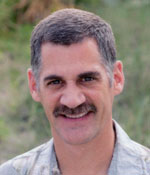
In early spring our squadron in Germany was sending 12 F-15s to Denmark to participate in a NATO flying exercise. The weather was overcast over Europe, and the forecast in Denmark was for low ceilings, poor visibility, and rain throughout the day. We scheduled three launches of four F-15s each spread apart by 20 minutes. I launched with the second group of four.
 It was VFR above 20,000 feet msl so our en route cruise was not a problem. Because of the low ceilings we planned for radar trail arrivals--we would receive one clearance for the flight of four and the other aircraft would use their air-to-air radar equipment to follow the flight lead, keeping one-nautical-mile spacing from the jet in front of them throughout the approach. With 20 minutes of spacing, the first flight should have been on the ground before we began the approach sequence, but the very busy radios on arrival frequency let us know that they were still airborne and lots of other fighters and airline traffic were trying to make it to their respective airports in the area. This was the kind of day where everyone was on his toes and where no slop was allowed with radio communications, even with trying to understand some of the Danish accents giving clearances in ICAO-standard English.
It was VFR above 20,000 feet msl so our en route cruise was not a problem. Because of the low ceilings we planned for radar trail arrivals--we would receive one clearance for the flight of four and the other aircraft would use their air-to-air radar equipment to follow the flight lead, keeping one-nautical-mile spacing from the jet in front of them throughout the approach. With 20 minutes of spacing, the first flight should have been on the ground before we began the approach sequence, but the very busy radios on arrival frequency let us know that they were still airborne and lots of other fighters and airline traffic were trying to make it to their respective airports in the area. This was the kind of day where everyone was on his toes and where no slop was allowed with radio communications, even with trying to understand some of the Danish accents giving clearances in ICAO-standard English.
The good news was I could tell that the Danish controllers were well ahead of the game and exuded confidence and calm among the chaos, so I knew we were all in good hands. They kept us informed of where each flight was in the arrival sequence, so nobody had to interject to ask for an update. Eventually we landed safely. After checking into our hotel, we made our way to a local pub for dinner, drinks, and “There I was” stories.
It didn’t take long for the stories to unfold from the day’s events, and shortly after that a Danish gentlemen leaned over to us and asked if we were the F-15 pilots who had arrived earlier in the day. When we answered, “Yes,” he followed by telling us that he was one of the approach controllers and the two guys sitting next to him also worked approach and arrival. What a small world!
We thanked them for the awesome service they provided and picked up their dinner and drink tab for the evening. It was nice to actually talk face to face with the “invisible” guys on the other end of the radio for a change. And it reinforced the fact that we’re all on the same team and all got the job done together that day.
Wouldn’t it be nice to talk with some controllers on the ground before you really need them in flight? You can. Many FAASTeam seminars use local tower and/or approach controllers to facilitate discussions with the local pilots. Almost every AOPA-sponsored Air Safety Institute seminar I have attended has had a local FAA controller in the audience. Finally, you can always call Lockheed Martin Flight Service (800/WX-BRIEF) and ask for tower or approach/departure control to call you back to help get your local questions answered--or to pass along kudos for a job well done.
Larry Brown of Colorado Springs, Colo., is a retired Air Force F-15 pilot who is using the lessons he learned as a fighter pilot as a GA pilot in his Cessna P210. Brown, who has 2,600 hours total time during his 32 years of flying, also was an instructor pilot and flight examiner in the Air Force T-38 and instructor pilot in the T-52, the military’s version of GA’s Diamond DA40. See previous installments in the Fly like a fighter archive.



